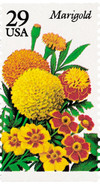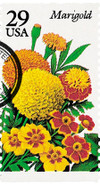
1994 29c Summer Garden Flowers: Marigold
# 2832 - 1994 29c Summer Garden Flowers: Marigold
$0.35 - $3.20
U.S. #2832
1994 Marigold
Stamp Category: Commemorative
Series: Garden Flowers
Value: 29c – First-Class postage rate
First Day of Issue: April 28, 1994
First Day City: Cincinnati, Ohio
Quantity Issued: 35,202,800
Printed By: Bureau of Engraving and Printing
Printing Method: Lithographed and engraved
Format: Printed in four panes of 5 vertical se-tenant stamps
Perforations: 10.9 vertically
Why the stamp was issued: Partof the 5-stamp “summer” booklet set of the Garden Flowers Series, the Marigold stamp was one of the “bright, pretty American stamps” the US Postal Service was hoping people would buy.
The stamp fulfilled the then-current first-class postage rate of 29c.
About the stamp design: The stamp was designed by artist Ned Seidler, who had designed the1993 garden flowers stamps. Seidler used the same clever technique as before, with the lily appearing to be part of the same bouquet, along with the lily, gladiolus, zinnia, and rose.
The painting was a combination of watercolor and gouache. Gouache is a thicker, opaque form of watercolor.
First Day of Issue Ceremony: The ceremony was held at the Greater Cincinnati, Ohio, Flower and Garden Show.
About the Series: On May 15, 1993, the USPS issued the first installment in the Garden Flower Series, which would honor flowers that bloom in each of the four seasons.
This series was born out of the 1992 Wildflowers issue. That project had begun when the USPS asked an artist to produce color sketches of a group of garden flowers. Instead, the artist gave the USPS illustrations of wildflowers. The USPS liked them so much, it decided to create a 50-stamp pane, showing wildflowers that can be found in each state.
The USPS still liked the garden flowers idea. Part of the push behind these stamps had come from the sale of stamps in supermarkets and other retailers. People said they wanted “bright, pretty American stamps.” The USPS decided flower booklets would please the public. It ran TV commercials and full-page advertisements in stamp publications announcing “The flowers are in bloom at your post office. Buy them while they last!” and “Pick up a bunch.” The Garden Flowers booklet was the first to be produced on the new Goebel booklet machine, which was the first to print multicolor covers.
The stamps were issued on May 15, 1993, in Spokane, Washington at the 55th annual Spokane Lilac Festival and International Lilac Society Convention. Though not announced at the time, these stamps were to be the first in a new series of seasonal flower booklets.
The second booklet in the series was issued on April 28, 1994, at the Greater Cincinnati, Ohio, Flower and Garden Show. It featured summer garden flowers. Some people took issue with one of the stamps, which used the word “gladiola” rather than gladiolus.
The third booklet in the series was issued on September 19, 1995, at the Quail Botanical Gardens in Encinitas, California. This booklet featured fall blooms, though some people noted that depending on where you live in the country, some of these flowers could grow in the summer or even the spring. One USPS representative responded that “The idea with this series was to show a grouping of flowers that would be together somewhere in a garden at the same time. It’s not scientific. It’s meant to be more for mass-market appeal, as opposed to botanical.”
The final booklet in the series was issued on January 19, 1996, in Kennett Square, Pennsylvania. The flowers selected for these stamps are the hardiest plants that grow anywhere in the country that experiences winter weather.
The history behind the stamp:
Marigolds are among the most popular flowers in American gardens. Exceedingly easy to grow, they reward gardeners with immense quantities of color, creating natural borders for walkways and gardens. They range in color from near-white through vivid yellows and oranges to reddish-browns. The marigold generally grows from twelve inches to over three feet in height.
Marigolds descended from a wild Mexican species and were brought to Europe in the 1500’s by Spanish explorers. Through the years they have been hybridized and developed to produce four different types – African or Aztec marigolds, French marigolds, African-French hybrids, and dwarf marigolds.
Massed alone or mixed with other flowers, marigolds show off their vivid beauty in beds, borders, and terrace pots. And their bright colors and long life make them ideal as cut flowers. But their versatility goes beyond the garden. In Mexico, acres of marigolds are grown for chicken feed. When the blossoms are fed to hens, they produce eggs with the dark yellow yolks Mexican housewives demand. And because of the pungent oil they produce, many gardeners use marigolds as a natural repellent against nematodes, small parasitic worms that live on plant roots.
U.S. #2832
1994 Marigold
Stamp Category: Commemorative
Series: Garden Flowers
Value: 29c – First-Class postage rate
First Day of Issue: April 28, 1994
First Day City: Cincinnati, Ohio
Quantity Issued: 35,202,800
Printed By: Bureau of Engraving and Printing
Printing Method: Lithographed and engraved
Format: Printed in four panes of 5 vertical se-tenant stamps
Perforations: 10.9 vertically
Why the stamp was issued: Partof the 5-stamp “summer” booklet set of the Garden Flowers Series, the Marigold stamp was one of the “bright, pretty American stamps” the US Postal Service was hoping people would buy.
The stamp fulfilled the then-current first-class postage rate of 29c.
About the stamp design: The stamp was designed by artist Ned Seidler, who had designed the1993 garden flowers stamps. Seidler used the same clever technique as before, with the lily appearing to be part of the same bouquet, along with the lily, gladiolus, zinnia, and rose.
The painting was a combination of watercolor and gouache. Gouache is a thicker, opaque form of watercolor.
First Day of Issue Ceremony: The ceremony was held at the Greater Cincinnati, Ohio, Flower and Garden Show.
About the Series: On May 15, 1993, the USPS issued the first installment in the Garden Flower Series, which would honor flowers that bloom in each of the four seasons.
This series was born out of the 1992 Wildflowers issue. That project had begun when the USPS asked an artist to produce color sketches of a group of garden flowers. Instead, the artist gave the USPS illustrations of wildflowers. The USPS liked them so much, it decided to create a 50-stamp pane, showing wildflowers that can be found in each state.
The USPS still liked the garden flowers idea. Part of the push behind these stamps had come from the sale of stamps in supermarkets and other retailers. People said they wanted “bright, pretty American stamps.” The USPS decided flower booklets would please the public. It ran TV commercials and full-page advertisements in stamp publications announcing “The flowers are in bloom at your post office. Buy them while they last!” and “Pick up a bunch.” The Garden Flowers booklet was the first to be produced on the new Goebel booklet machine, which was the first to print multicolor covers.
The stamps were issued on May 15, 1993, in Spokane, Washington at the 55th annual Spokane Lilac Festival and International Lilac Society Convention. Though not announced at the time, these stamps were to be the first in a new series of seasonal flower booklets.
The second booklet in the series was issued on April 28, 1994, at the Greater Cincinnati, Ohio, Flower and Garden Show. It featured summer garden flowers. Some people took issue with one of the stamps, which used the word “gladiola” rather than gladiolus.
The third booklet in the series was issued on September 19, 1995, at the Quail Botanical Gardens in Encinitas, California. This booklet featured fall blooms, though some people noted that depending on where you live in the country, some of these flowers could grow in the summer or even the spring. One USPS representative responded that “The idea with this series was to show a grouping of flowers that would be together somewhere in a garden at the same time. It’s not scientific. It’s meant to be more for mass-market appeal, as opposed to botanical.”
The final booklet in the series was issued on January 19, 1996, in Kennett Square, Pennsylvania. The flowers selected for these stamps are the hardiest plants that grow anywhere in the country that experiences winter weather.
The history behind the stamp:
Marigolds are among the most popular flowers in American gardens. Exceedingly easy to grow, they reward gardeners with immense quantities of color, creating natural borders for walkways and gardens. They range in color from near-white through vivid yellows and oranges to reddish-browns. The marigold generally grows from twelve inches to over three feet in height.
Marigolds descended from a wild Mexican species and were brought to Europe in the 1500’s by Spanish explorers. Through the years they have been hybridized and developed to produce four different types – African or Aztec marigolds, French marigolds, African-French hybrids, and dwarf marigolds.
Massed alone or mixed with other flowers, marigolds show off their vivid beauty in beds, borders, and terrace pots. And their bright colors and long life make them ideal as cut flowers. But their versatility goes beyond the garden. In Mexico, acres of marigolds are grown for chicken feed. When the blossoms are fed to hens, they produce eggs with the dark yellow yolks Mexican housewives demand. And because of the pungent oil they produce, many gardeners use marigolds as a natural repellent against nematodes, small parasitic worms that live on plant roots.












